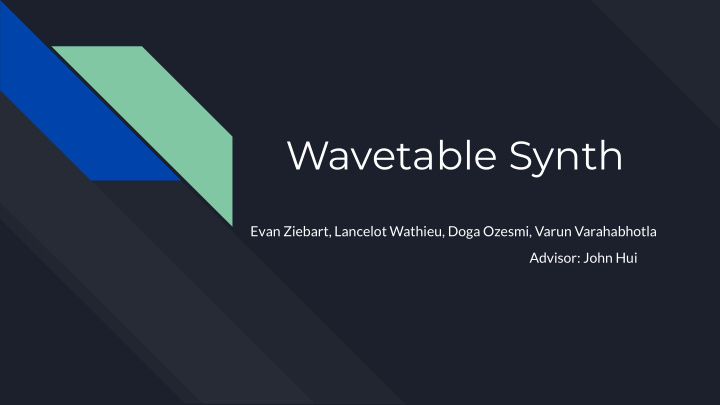



Wavetable Synth Evan Ziebart, Lancelot Wathieu, Doga Ozesmi, Varun Varahabhotla Advisor: John Hui MIDI WavetableSynthe
Overview
Wavetable Synthesis A sound wave signature is stored in memory ● Loop through this wave to make a sound ●
Different Notes Suppose a wave is sampled at 440 Hz and stored ● To sample at 880 Hz, skip every other address ● 1320 Hz = every third ●
MIDI Instruments Send status of key press and release ●
Our Design Send MIDI packets over USB to software synth program ● Synth converts MIDI signal data into calls to a hardware driver ● The driver accepts configuration of pitches (up to 10 notes) ● Each note requests samples from sampler ● Sampler can take samples from 2 wavetables and combine them with different ● coefficients The current samples can be configured from the software program ● The samples from all the 10 notes are combined and sent via interface to audio codec ●
Synth Software
Software: MIDI Decoder The MIDI decoder program is responsible for taking the MIDI Protocol messages utilizing ● the Libusb software library and translating the instructions into logic output: MIDI Packets are 64 bytes ○ note, attack velocity, modulation ○ Wave tales generated through Matlab and conversion script in python for any .wav files ● which normalizes the audio format.. 48kHz ○ 16bit ○
Matlab Generated Audio Waves sine_wave pulse_wave saw_wave triangle_wave Python Audio Waves Converter Use existing .wav files and Hardware MIDI_SW_Driver convert to 48kHz, 16bit MIDI Driver Libusb Input MIDI Data audio Setup Memory Mapped IO send_note Write Data to buff send_wave start_wave MIDI Input Device Keyboard Device which sends in MIDI Commands
Synth Hardware
NOTES Wave Table 0 Wave Table 1 DRIVER Wave Table 2 AUDIO CODEC
Data from driver, destination note controlled by top level module Note Data: Note, Octave, Velocity Wave Sample Counters
ADSR enveloping Attack ● Decay ● Synthesis ● Release ●
Wave Tables 2 wavetables for reading Wave Table 0 1 wavetable for writing Swap these around whenever a different wave is loaded Wave 0 Wave Table 1 Wave 1 Wave Table 2
Wave Tables 2 wavetables for reading Wave 0 Wave Table 0 1 wavetable for writing Swap these around whenever a different wave is loaded Wave Table 1 Wave 1 16 bits * 48,000 samples * 3 waves = Wave Table 2 288kB used
NOTES Wave Table 0 Wave Table 1 DRIVER Wave Table 2 AUDIO CODEC
Performance Constraints Time to write from memory to wavetables in BRAM is negligible Longest portion of hardware is taken by the arbiter Still responds to Codec requests about ~10 times faster than necessary
What works: Testbenches for each individual module Testbenches for each major module (wavetables, note_top) Software for interpreting MIDI signals Software driver for the synth hardware Interfacing with the Audio Codec What doesn’t: When they all come together
Recommend
More recommend